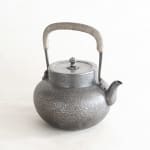



Koukan Murata
Silver Kettle, 1930s
Sold
Further images
Here is a tea kettle, simple and recognizable as just that. It is lustrous and gracefully subdued, with a hammered metal surface and a leather-bound handle. This kettle has been...
Here is a tea kettle, simple and recognizable as just that. It is lustrous and gracefully subdued, with a hammered metal surface and a leather-bound handle. This kettle has been used in the casual enjoyment of tea for nearly a century, made by Koukan Murata in the 1930s. Its metal body has felt the wear of repeated use and the steady care of maintenance; its elegant design holds the residue of history. Time and time again, this kettle was chosen in the moment to boil water for the experience of tea. Like an old friend, it has proved faithful to many users before it traveled to where it is today.
This kettle was produced from the sensibilities of a chosen craftsman for a family of the Yabunouchi School, one of Japan’s oldest schools of Chanoyu (tea ceremony), which the Mitsui family has long supported. It has the stamp of its maker, Koukan Murata, as well as his signature on the lid of its original wooden container. While an object with its own feel and nuance, this kettle is a representation of something much larger, the philosophy of an aesthetic experience maintained with quiet passion since the 16th century. The Yabunouchi way of tea is said to be one of the most classical of Chanoyu styles, its ritual defined by a masculine and heroic sensibility. Such can be observed by the clean, straightforward appearance of this kettle, its confident, exacting shape, and the meticulous hammering and craftsmanship of its surface. It is an ideal of a kettle, a perfect, heroic model in and of itself.
Yet, despite its perfection and history, this object is approachable. It is made to be used, and the refinement of its design only aids in its function. One can equally imagine this kettle as a supporting instrument of tea enjoyment in 1930’s Japan, or as a humble container for pouring an early morning cup of English breakfast in the contemporary western home space. In fact, the sleekness of the kettle’s design and the delicate patina of its silver appear to anticipate the earthy modernism of American architecture of the 20th century: confident, robust, and forward facing. As a precursor to these western concepts of design, the kettle can fit perfectly in any modern home space. Yet still, although its lineage calls only to a casual, supporting role in the tea ceremony, it allows its user a sideways glance into the Japanese practice of tea. Either way, the kettle fulfills its purpose, and continues its own tradition of use and care. Like a reliable ideal, it stands consistently across time and setting.
This kettle was produced from the sensibilities of a chosen craftsman for a family of the Yabunouchi School, one of Japan’s oldest schools of Chanoyu (tea ceremony), which the Mitsui family has long supported. It has the stamp of its maker, Koukan Murata, as well as his signature on the lid of its original wooden container. While an object with its own feel and nuance, this kettle is a representation of something much larger, the philosophy of an aesthetic experience maintained with quiet passion since the 16th century. The Yabunouchi way of tea is said to be one of the most classical of Chanoyu styles, its ritual defined by a masculine and heroic sensibility. Such can be observed by the clean, straightforward appearance of this kettle, its confident, exacting shape, and the meticulous hammering and craftsmanship of its surface. It is an ideal of a kettle, a perfect, heroic model in and of itself.
Yet, despite its perfection and history, this object is approachable. It is made to be used, and the refinement of its design only aids in its function. One can equally imagine this kettle as a supporting instrument of tea enjoyment in 1930’s Japan, or as a humble container for pouring an early morning cup of English breakfast in the contemporary western home space. In fact, the sleekness of the kettle’s design and the delicate patina of its silver appear to anticipate the earthy modernism of American architecture of the 20th century: confident, robust, and forward facing. As a precursor to these western concepts of design, the kettle can fit perfectly in any modern home space. Yet still, although its lineage calls only to a casual, supporting role in the tea ceremony, it allows its user a sideways glance into the Japanese practice of tea. Either way, the kettle fulfills its purpose, and continues its own tradition of use and care. Like a reliable ideal, it stands consistently across time and setting.
Signup for our Newsletter
You will receive two emails a month from us. One introduces artworks and design works from Kyoto's hidden sources and the other is stories from Misako, sharing insights into Japanese culture.
* denotes required fields
为了回应您的查询,我们将根据我们的隐私政策处理您提供的个人数据。



